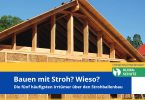The results of comparative tests of thermal insulating materials on the basis of various agricultural wastes are presented. Rye straw, barley straw, wheat straw, oats straw, rice straw, flax boon and rice husk were used in the experimental program along with three types of binders (liquid glass, emulsion of PVA and latex). Plates prepared with rye straw and flax boon fibers and liquid glass as a binder have the best physical and mechanical characteristics due to the formation of the optimal composite structure of the material from two fibers of different sizes and shapes. The electronic microscopy of rye and flax stems made it possible to establish the presence of outer and inner parts in the structure, which affect the thermal and strength characteristics. Results show that plates made from rye straw and flax boon have lower moisture absorption, unlike the rye straw-based ones.
The results of full-scale tests with a ventilated thermal insulation system confirm the effective operation of rye straw and flax boon plates. The testing program carried out indicates the possibility of using an environmentally friendly straw-flax boon plate for thermal insulating buildings in the cold period and thereby reducing carbon dioxide emissions into the atmosphere.
Authors:
- Bakatovich, Aliaksandr
- Davydenko, Nadezhda
- Gaspar, Florindo
Link: http://www.sciencedirect.com/science/article/pii/S0378778818311484







